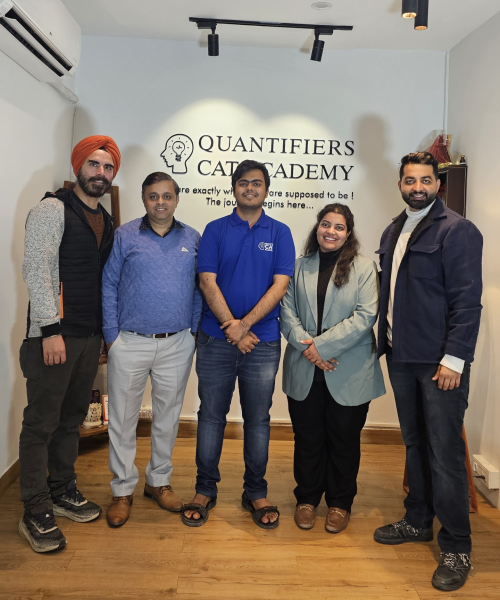- CAT Courses
- Free Video Resources & Tests
Video Resources
...
- Super 75
- CAT Past Papers
- Free Study Material
- BlogsDecember 23, 2025
XAT Time Management Tips 2026
December 21, 2025XAT Decision Making & GK Guide with PYQs for 2026 Prep
- Results
Home » SNAP 2025 Notification Out – Check Dates, Eligibility, Fees, Pattern
Everything you need to know about SNAP 2025
SNAP 2025 registration is now open, and aspirants aiming for top Symbiosis colleges need a clear understanding of dates, pattern, eligibility, and preparation. Below is a comprehensive, structured view with all key data organized into easy-to-read tables.
We hope you find this blog informational. If you want a FREE DEMO, click here.

Quantifiers CAT Academy, Chandigarh
SNAP 2025 registration open from 1 August to 20 November 2025
Exam dates:6, 14, and 20 December 2025 (attempt up to 3 times!)
Eligibility: Bachelor’s degree with 50%+ (45%+ for SC/ST/PwD)
Pattern: 60 mins, 60 questions (MCQs), no sectional timing
Results: 9 January 2026
Final Merit List: Late March 2026
The official SNAP 2025 notification is out! If you’re targeting top MBA programs under Symbiosis International University, this exam is crucial. Here’s all you need to know — in one place.

Event | Date / Timeline |
Notification Release | 1 August 2025 |
Registration Open | 1 August 2025 |
Registration Close | 20 November 2025 |
Admit Card Release | Test 1: 28 Nov, Test 2: 8 Dec, Test 3: 15 Dec |
Exam Dates | 6, 14, 20 December 2025 |
Results | 9 January 2026 |
GE-PI-WAT | Mid-February 2026 |
Final Merit List | Late March 2026 |
Here’s how the exam will be structured:
Component | Details |
Mode | Computer-Based (Online) |
Duration | 60 minutes |
Total Questions | 60 |
Sections | General English (15), Quant + DI + DS (20), Logical Reasoning (25) |
Marking Scheme | +1 per correct, –0.25 per incorrect |
Attempts Allowed | Up to 3 (Best score considered) |
Sectional Time Limit | None |
To appear for SNAP 2025:
Understand the fee structure before applying:
Fee Type | Amount |
SNAP Exam Fee | ₹2,250 per attempt (+ GST) |
Programme Application Fee | ₹1,000 per Symbiosis institute/program |
🆓 Free Resources for SNAP Preparation (by Quantifiers CAT Academy)
SNAP is accepted by all Symbiosis institutes, including:
SIBM Pune
SCMHRD Pune
SIIB
SIBM Bangalore
SITM, SIMC, SIDTM, SSBF & others
📘 Each college has a separate cut-off and application form. Apply individually to each program of interest.
With SNAP 2025 registrations now live, this is your chance to secure a seat at one of the prestigious Symbiosis institutes. From key dates to the updated exam pattern and eligibility criteria, everything you need to know has been covered above. Now it’s time to shift gears and focus on smart preparation. Whether you’re targeting SIBM Pune, SCMHRD, SIIB, or other top Symbiosis colleges, early planning and practice can make all the difference. Don’t forget to leverage Quantifiers’ free study material, mock tests, and expert-curated CAT+SNAP resources to level up your prep. Stay updated, stay consistent, and aim for your best attempt out of three!
Yes. You can take up to 3 attempts. The best score is considered for final selection.
SNAP is shorter (60 mins), has easier difficulty, and no sectional time limits.
It will be conducted online as a computer-based test (CBT).
You need to apply separately to each institute after paying SNAP exam fee.
While no official syllabus is released, SNAP generally covers QA, LR, DI, and English.
It is a 60-minute online test with 60 questions divided into General English (15), Quant + DI + DS (20), and Logical Reasoning (25). Each correct answer fetches +1, and there’s a -0.25 penalty for wrong answers.
Yes, final-year undergraduate students can apply. Their admission will be provisional until they provide proof of graduation.
No, there is no sectional time limit. You can navigate between sections freely within the 60 minutes.
The SNAP exam fee is ₹2,250 per attempt (+ GST), and you’ll need to pay ₹1,000 per institute/program you apply to.
SNAP is accepted by Symbiosis International University and its affiliated institutes like SIBM Pune, SCMHRD, SIIB, SIMS, SITM, SIBM Bangalore, and many more.
To connect with us, for mentorship and daily test practice
DM us on Instagram or WhatsApp. We reply back 24/7. Get your CAT prep started

We at Quantifiers understand and deliver on the personal attention each of our students requires. Whether it is through our pedagogy that enables non-engineers or non-math background students, our constant effort to proactively provide solutions, or our focus on our student’s goals.